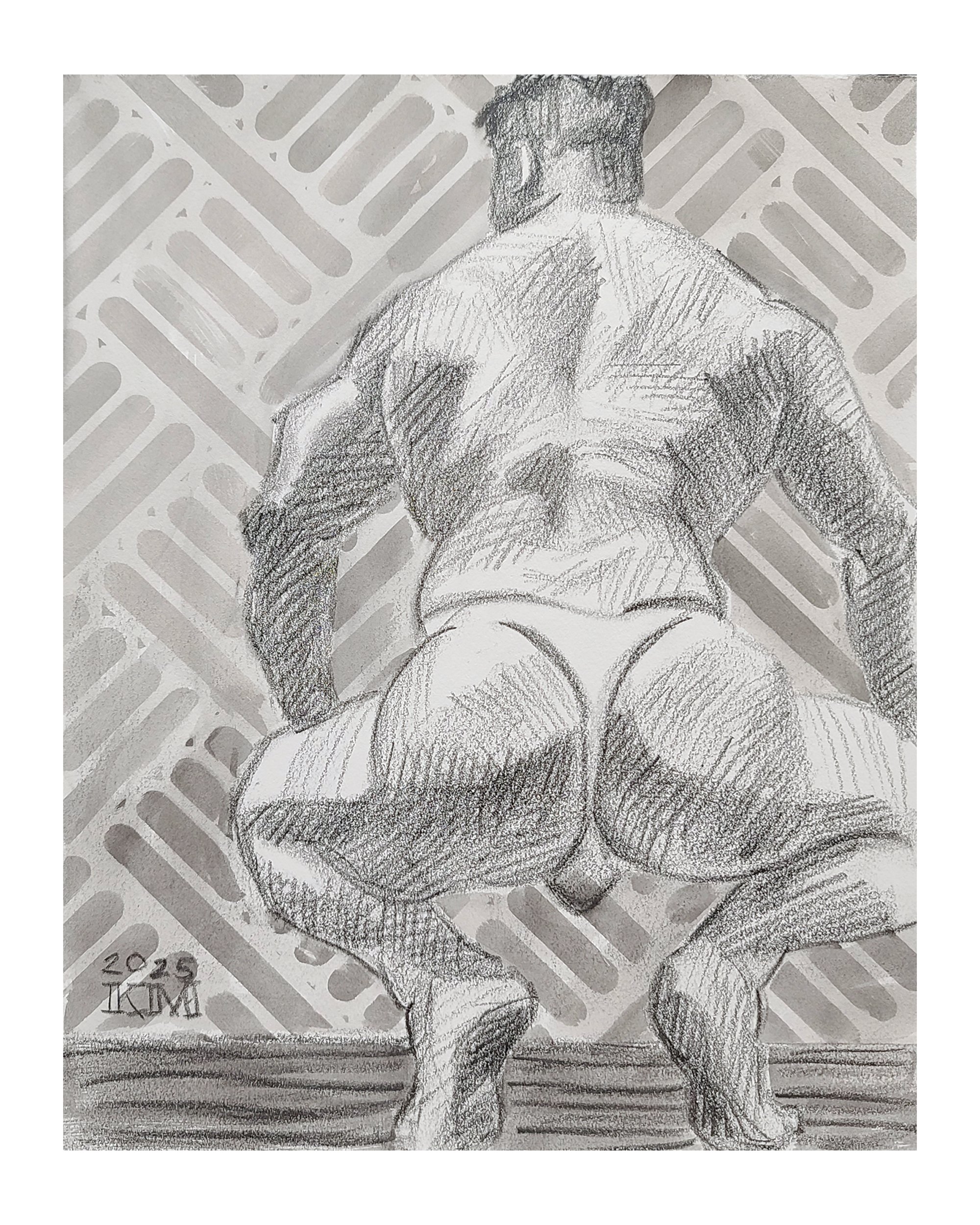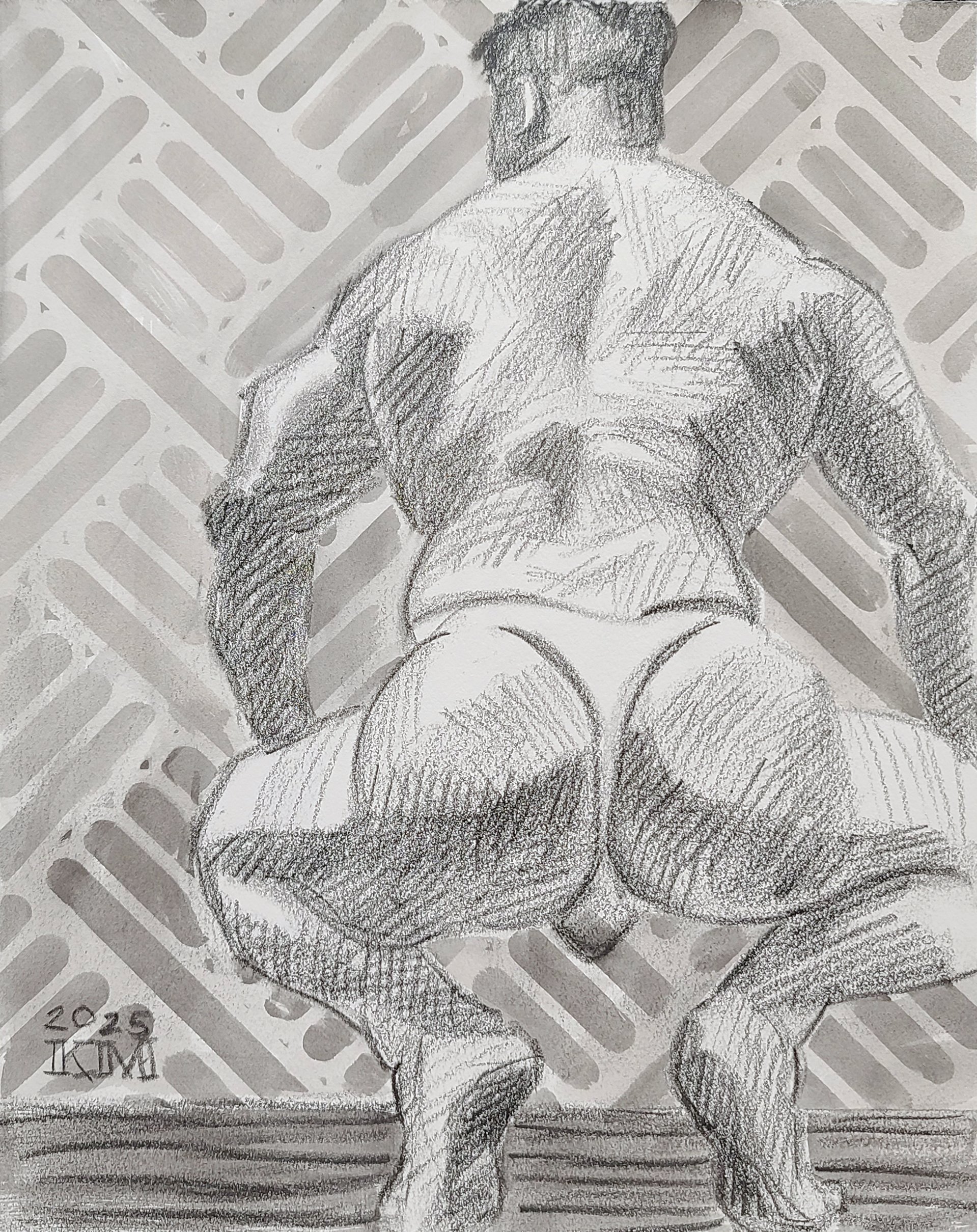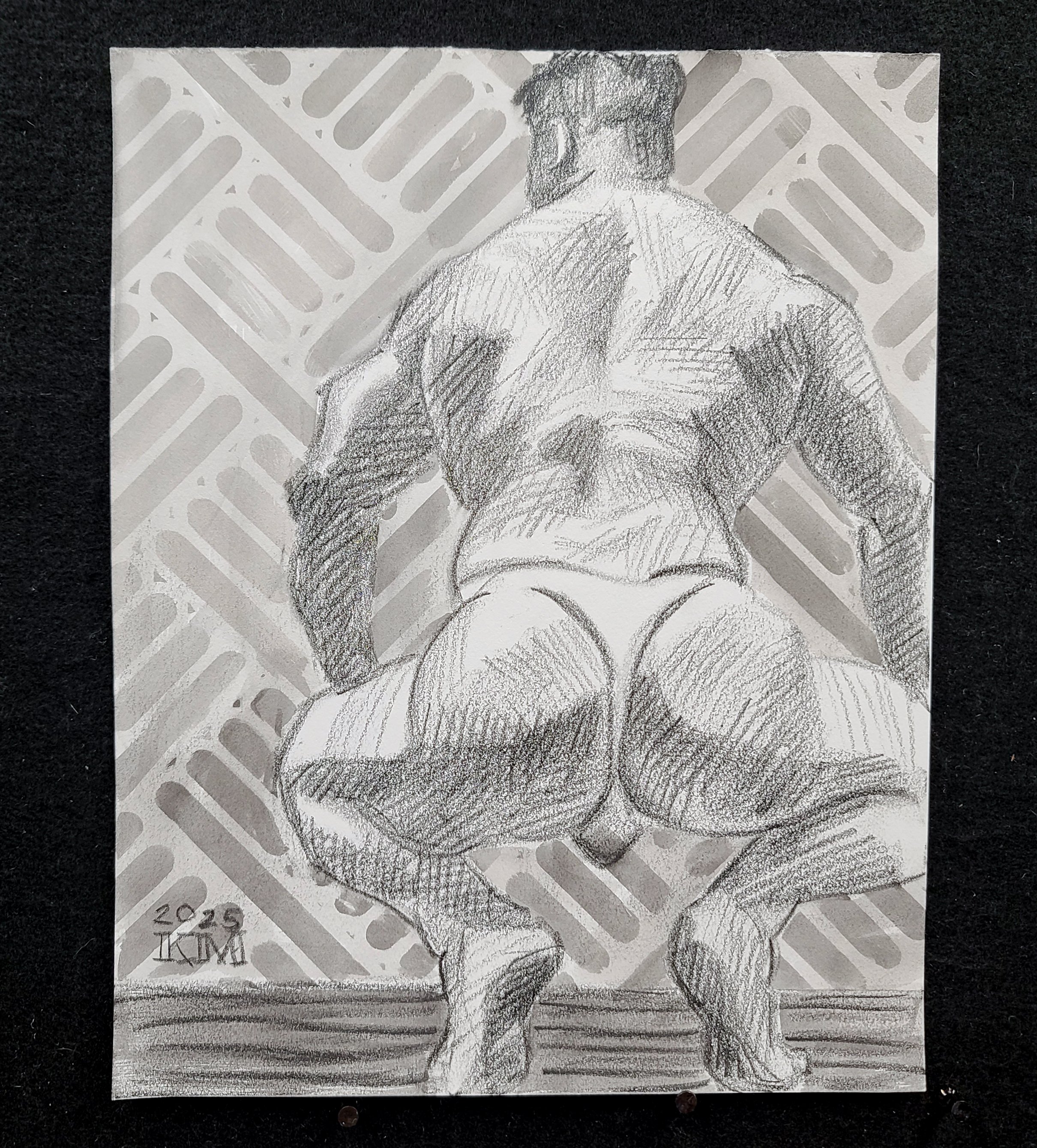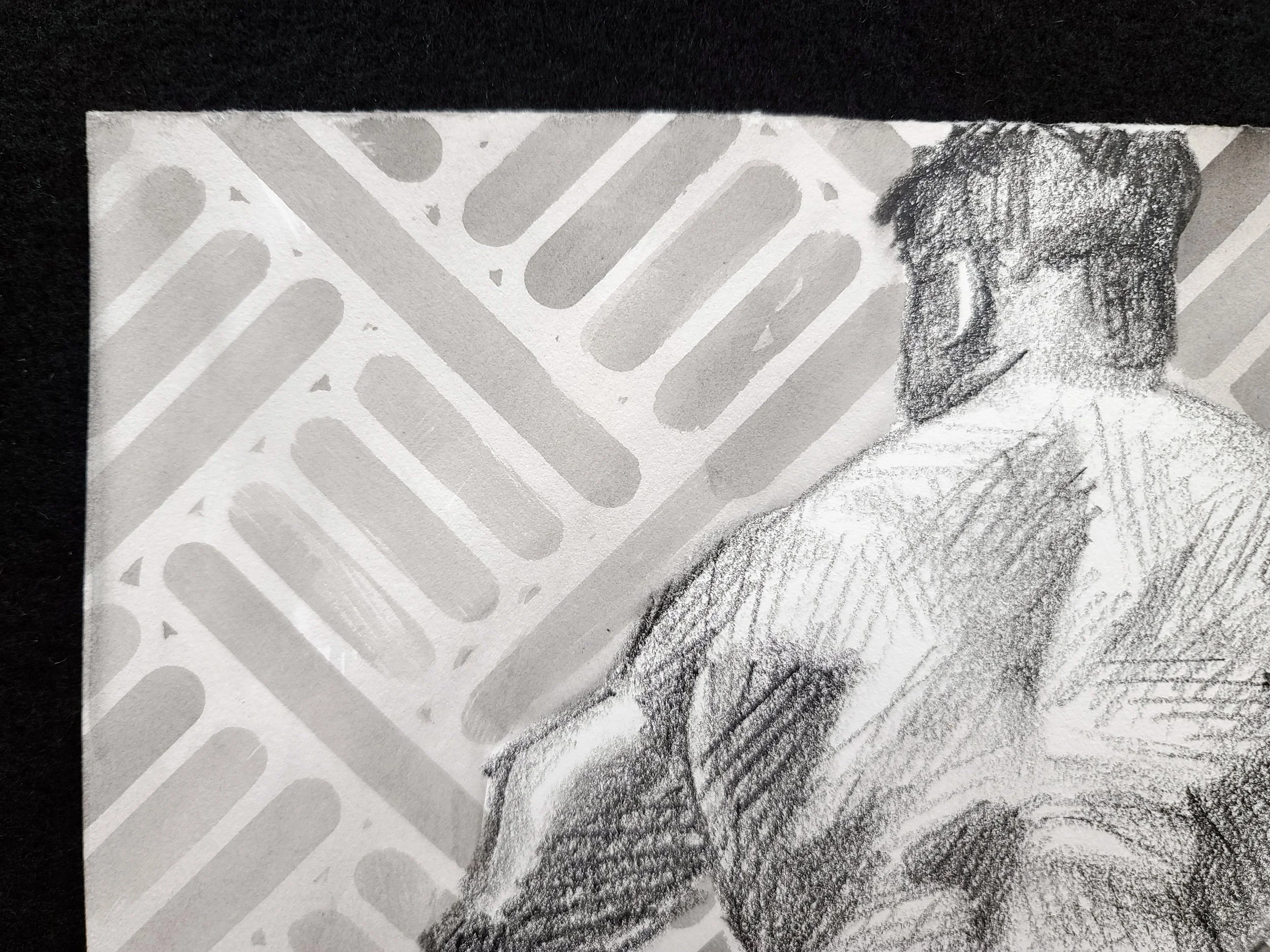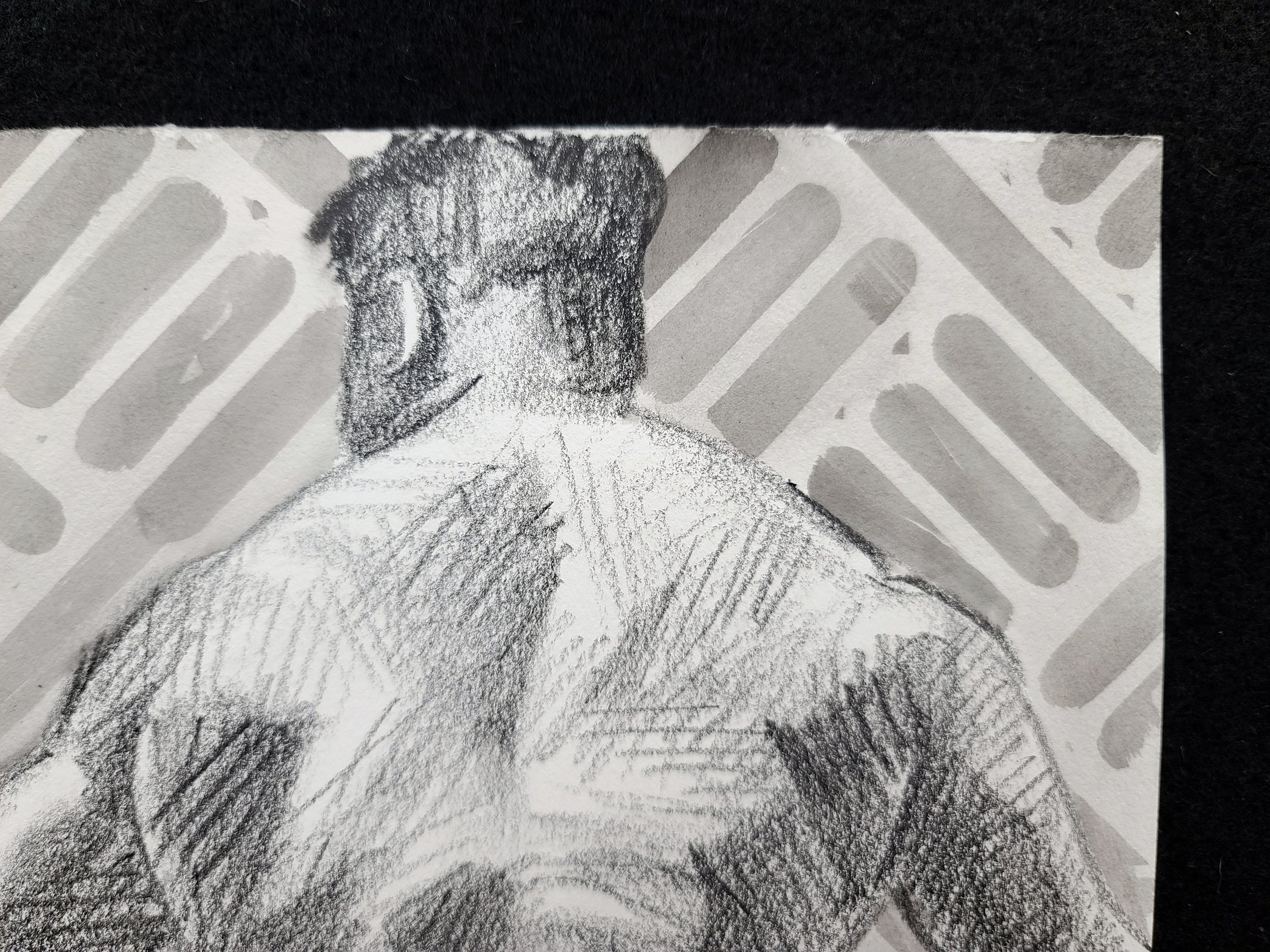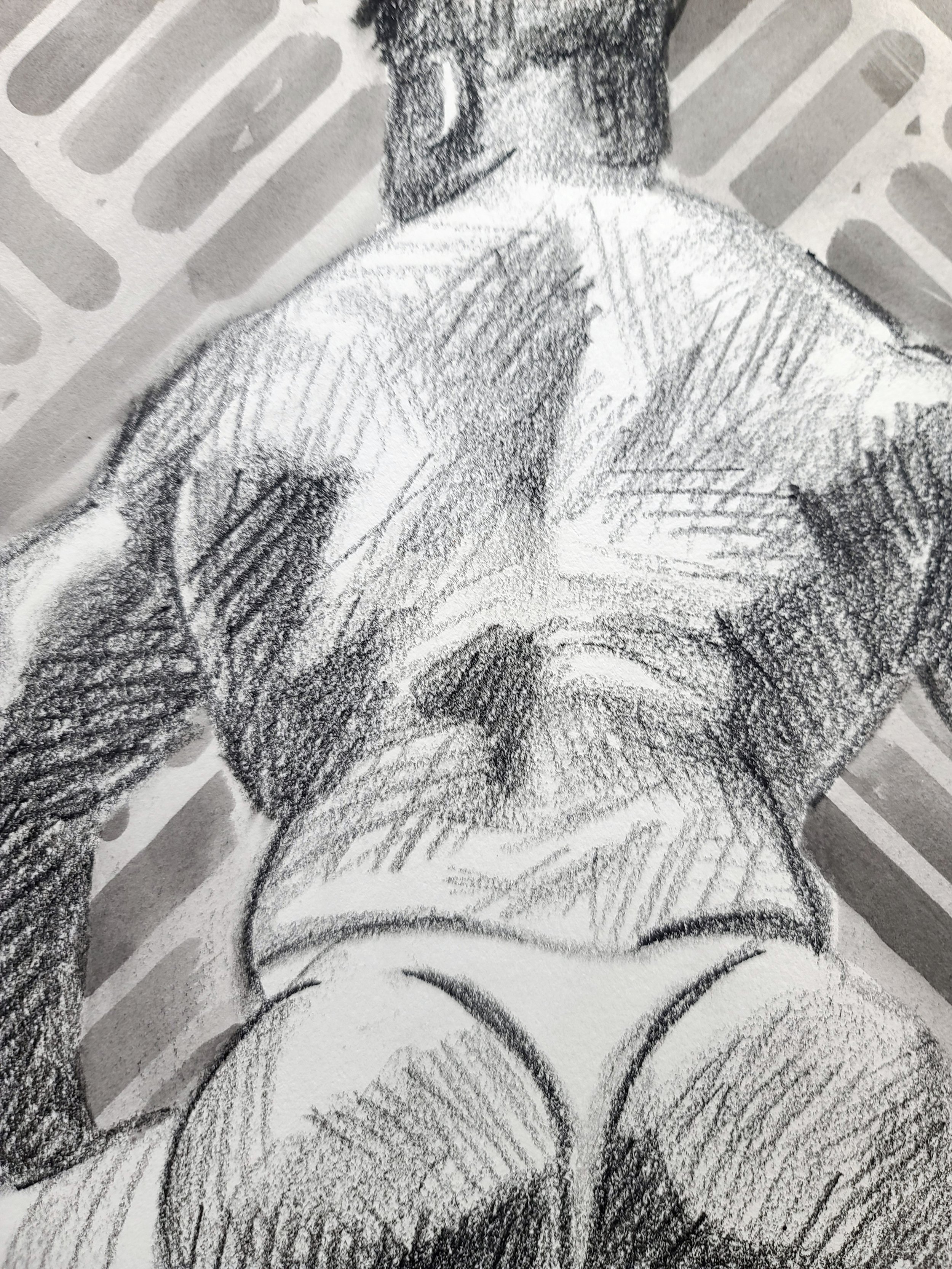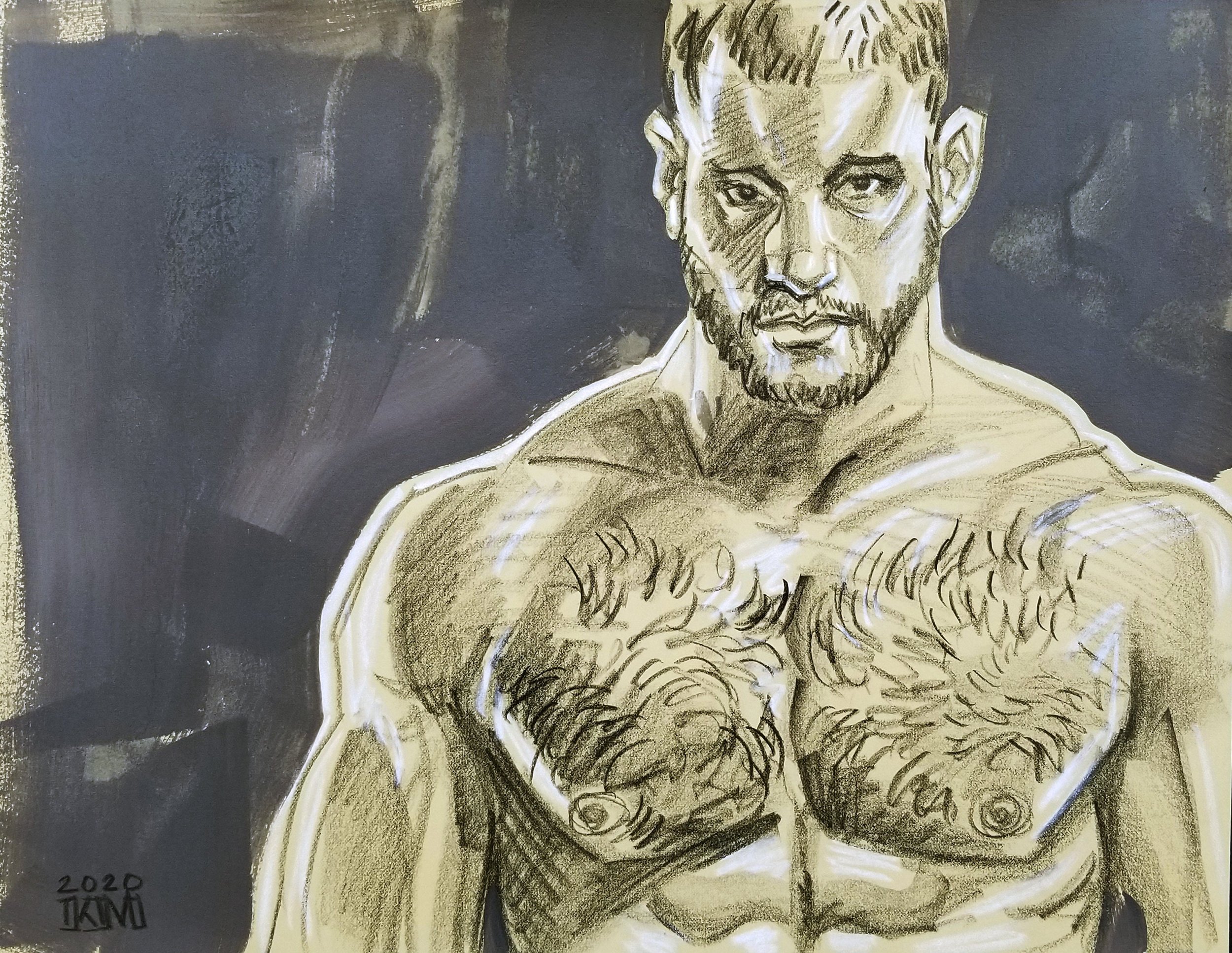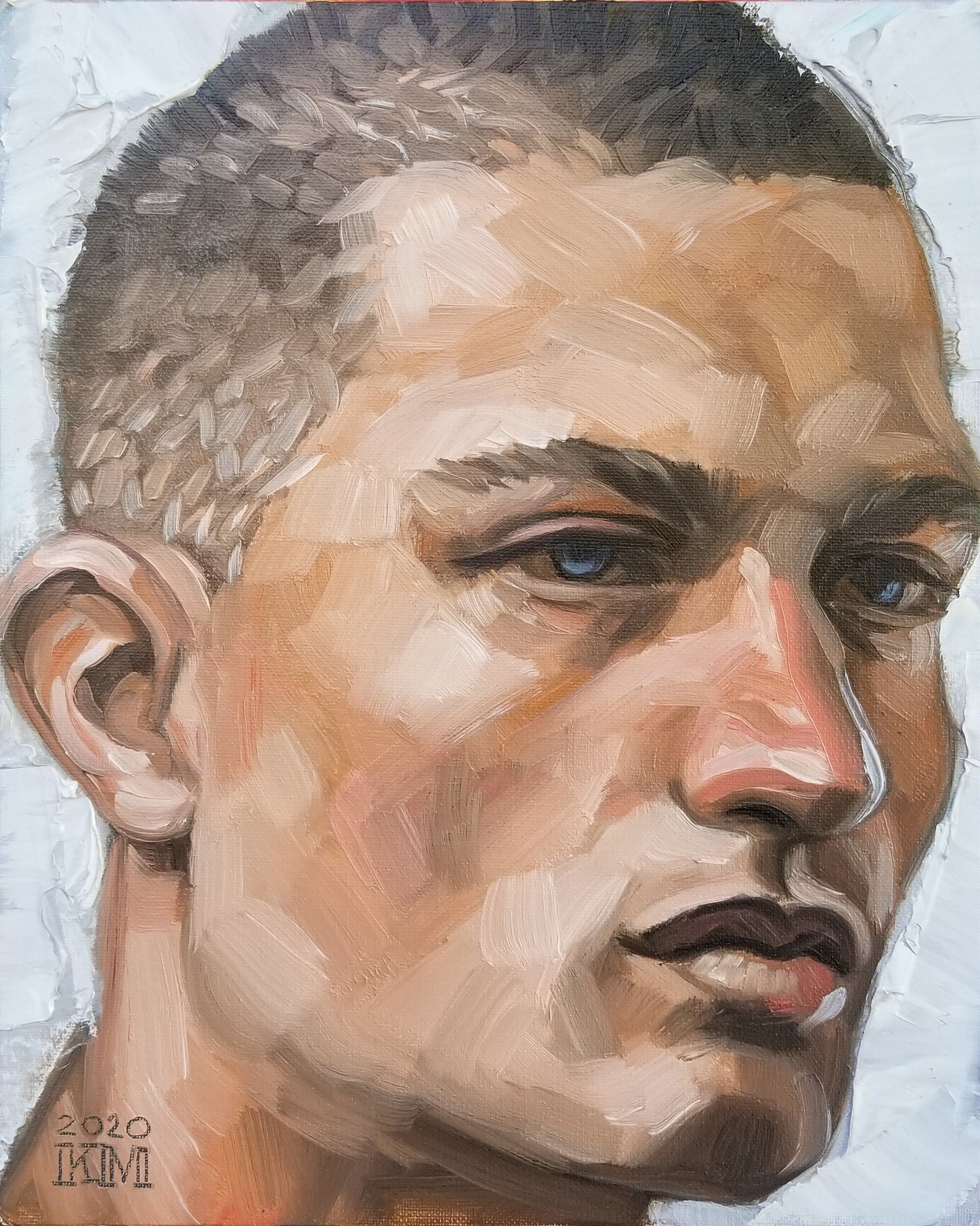 Image 1 of 7
Image 1 of 7

 Image 2 of 7
Image 2 of 7

 Image 3 of 7
Image 3 of 7

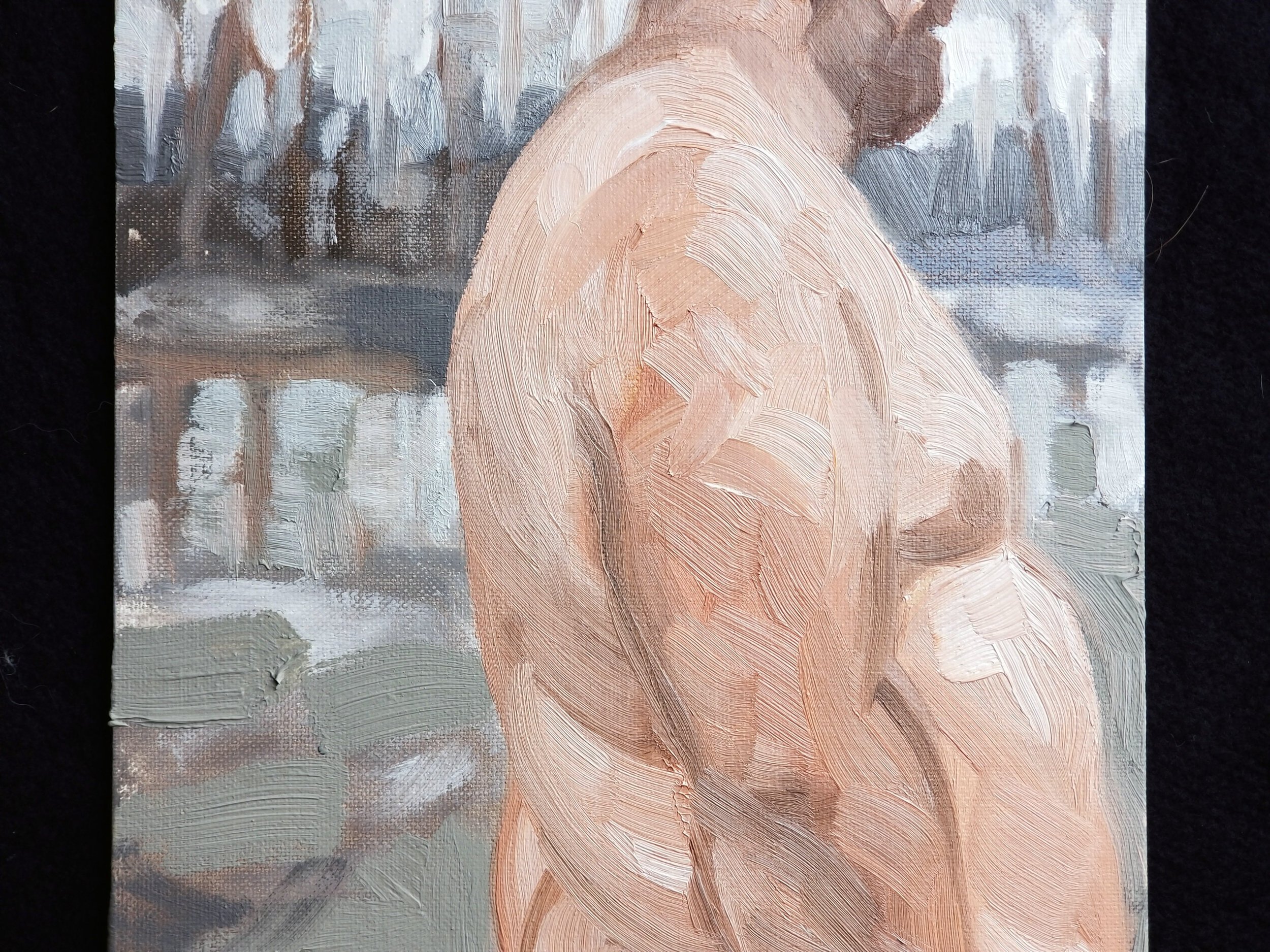 Image 4 of 7
Image 4 of 7

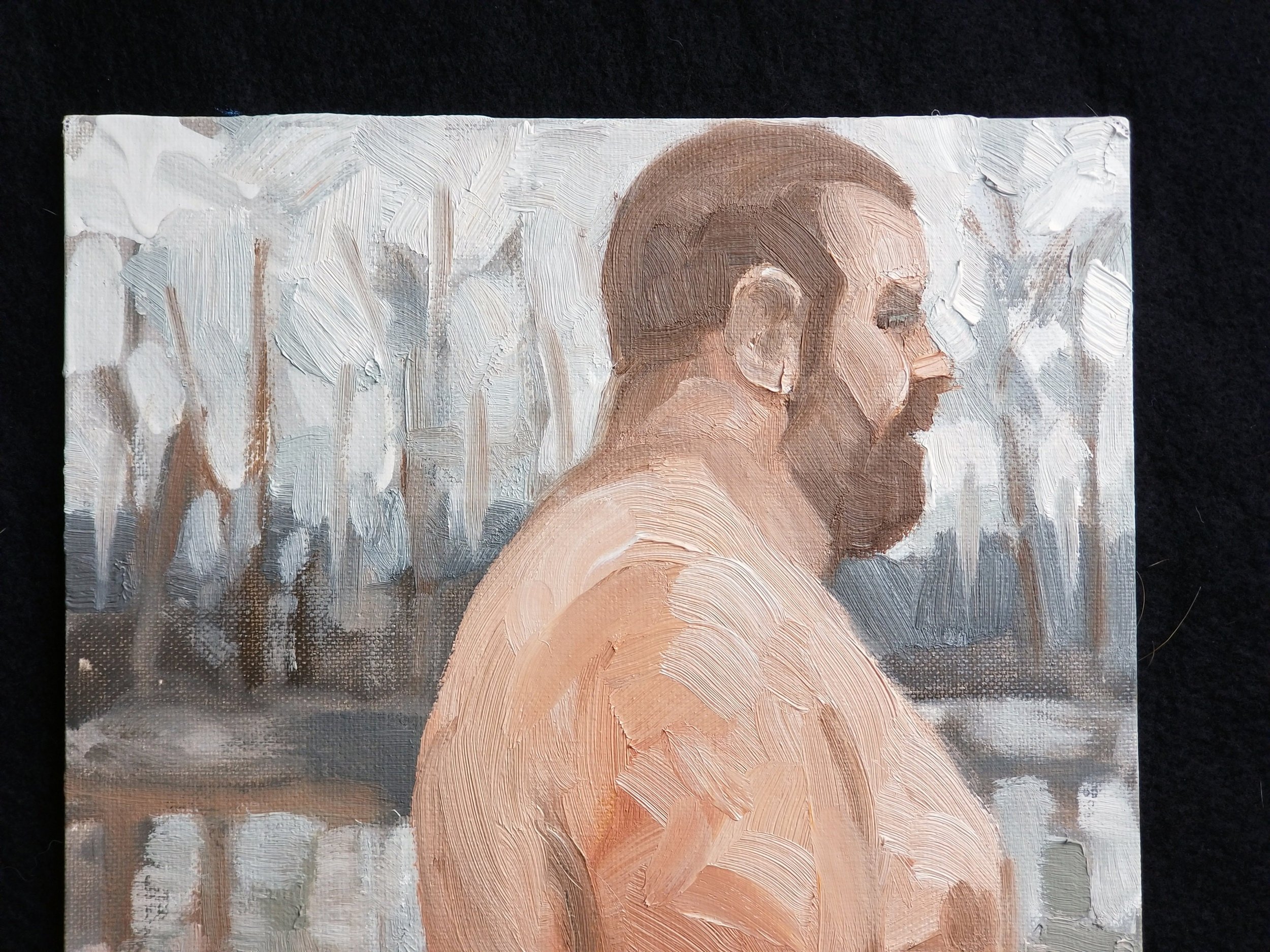 Image 5 of 7
Image 5 of 7

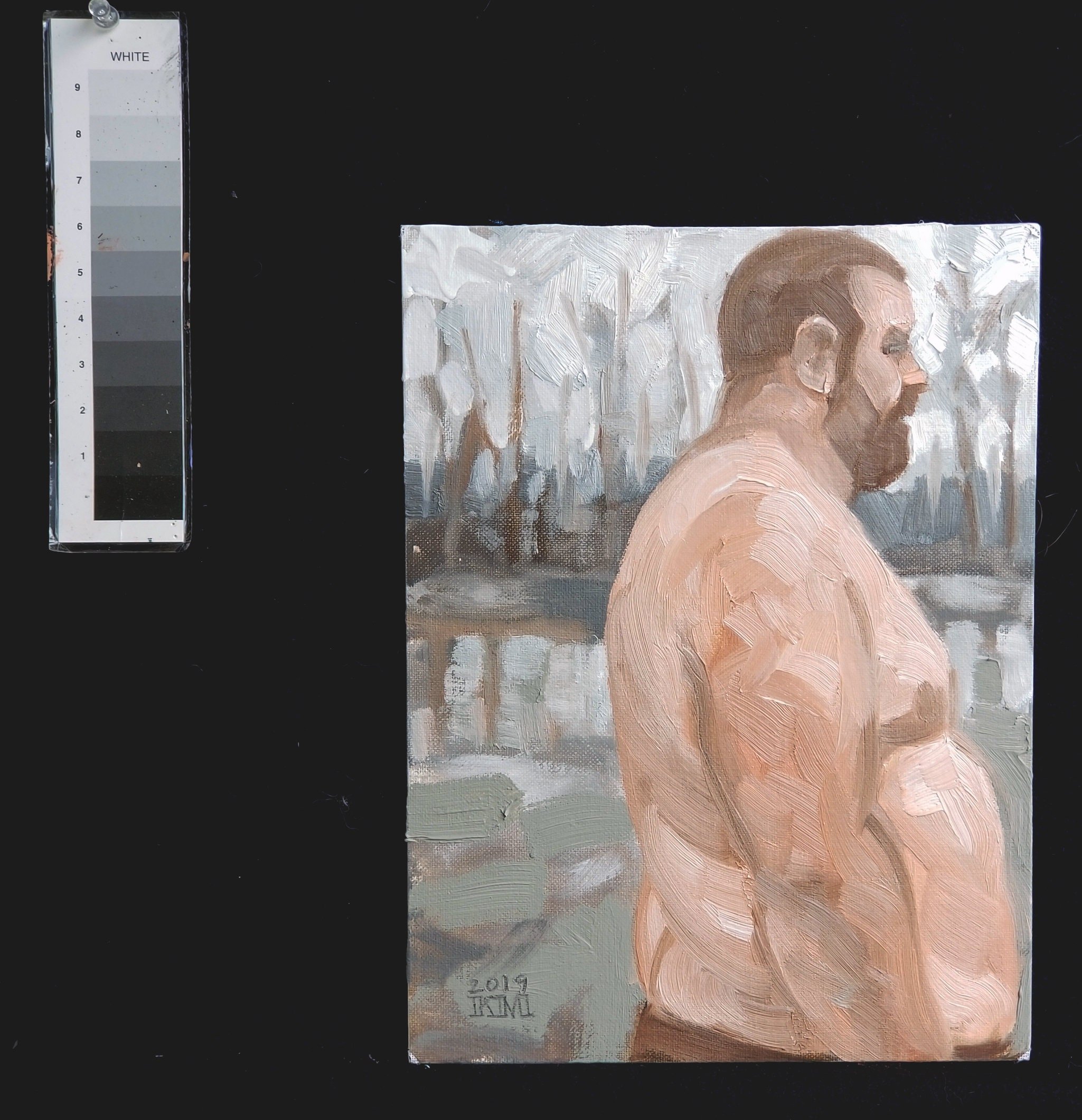 Image 6 of 7
Image 6 of 7

 Image 7 of 7
Image 7 of 7








Middle Aged Bear About to Attack the Object of His Desire, 9x12" oil on canvas panel by Kenney Mencher LGBTQ gay art homoerotic pride decor
$275.00
Sold Out
FREE SHIPPING
THIS WORK IS ORIGINAL (NOT A PRINT OR GICLEE)
Shipping takes 3-4 Weeks
There are a couple of paintings in my body of work that I keep coming back to and considering putting away and holding onto for my own viewing pleasure and possibly for my Guggenheim retrospective that I’ll be having as soon as I become famous.
This painting means more to me than any of the stereotypically “beautiful” masculine or or muscular beefy men that seem to be the staple of my collectors’ appetites.
This painting dates from 2019 and I remember the day I finished it I was so delighted with the formal aspects of the painting that I put it away for several weeks before I even offered it up on my website. When I’m talking about the “formal” aspects I’m talking specifically about the color, composition, drawing, and texture.
The muted palette is something that I don’t work with as much as I used to earlier in my career. I love the warm and cool grays of this painting and how they portray a mood of overcast light in a damp possibly cool environment that sets the figure off in the foreground. He’s not placed in a bull’s-eye point of view. I shifted his head off to the upper right-hand corner of the image and I wanted to feel as if he was leaving the picture plane but that his belly was leading the way. The texture and the mark making art almost draftsman like. I feel like I’m relying less on shading and value structure and more on lines and mark making to define this figures anatomy and the mood.
For me, especially since I am in my middle-age, the feeling of this figure is almost a metaphorical or emotional self-portrait. I feel that the gray palette and slightly slumped shoulders express something about me that I can’t quite put into words.
In gay culture, a bear is a larger and often hairier man who projects an image of rugged masculinity.
Many straight folks are unaware of the bear subculture. Hardly a surprise, since a powerful majority rarely concerns itself with the doings of a marginalized minority. When, three or four years ago, I first mentioned bears to my straight colleagues in the English Department at Virginia Tech, none of them knew what I was talking about, though by now at least one of them calls me “The Bear.” Similarly, my heterosexual students, as expert as they might be on current media, seem equally ignorant about this topic.
Most GLBT folks, however, by now seem to know the basics. A “bear” is a hairy, bearded, brawny-to-bulky gay man, usually displaying aspects of traditional masculinity. A cub is a younger version of the same; a wolf is a lean, hairy man; an otter a young version of that. “Woof!” is a lustful expression, meaning essentially: “Tasty! I’d like to climb all over that!” “Grrrrr!” means much the same. As you can see, after twenty-some years of development, the bear community, like any subculture, has its own jargon, sometimes called “bearspeak” or “vocabulary.” It also has its own values, its own style, and its own commodities. There are bear-oriented bars, festivals, music, movies, magazines, and books. There are regional clubs for bears not only in metropolitan centers, where the communities first developed, but also in rural areas.
I try to make really well crafted work about the human figure and the human condition. I focus on the kind of beauty for both men and women that is "non-standard." I'm most interested in representing people who don't get represented by mainstream artists. I particularly like painting bears, cubs, and other wildlife.
I am not a risqué or sexy kind of guy, however, at times some of my work has been called that. This is only a small part of what my paintings are about. The majority of my work deals with the visual translation of familiar ideas.
My images are about points of view, my own and the person who is looking at my work. These images are designed to provoke discussion about the politics of how we see the world. Many images are based on the visual, literary, and spoken clichés that we are inculcated with through movies, television, and print media. These paintings indirectly reference how the media forces us to see the world but even though the media seeks to find a homogenous point of view, we all see things differently. My paintings are ink blot tests and they beg the question, what’s your point of view?
The size is a standard US frame size and can be framed inexpensively.
(Buy framing kits on the US version of Etsy, Amazon or go to DickBlick. (.com's)
Learn more about me on my website.
www.kennEy-mencher.com
Warning these are the only sites authorized to sell my art:
https://www.etsy.com/shop/kmencher
https://www.kenney-mencher.net/
http://kenney-mencher.com/
THIS WORK IS ORIGINAL (NOT A PRINT OR GICLEE)
Shipping takes 3-4 Weeks
There are a couple of paintings in my body of work that I keep coming back to and considering putting away and holding onto for my own viewing pleasure and possibly for my Guggenheim retrospective that I’ll be having as soon as I become famous.
This painting means more to me than any of the stereotypically “beautiful” masculine or or muscular beefy men that seem to be the staple of my collectors’ appetites.
This painting dates from 2019 and I remember the day I finished it I was so delighted with the formal aspects of the painting that I put it away for several weeks before I even offered it up on my website. When I’m talking about the “formal” aspects I’m talking specifically about the color, composition, drawing, and texture.
The muted palette is something that I don’t work with as much as I used to earlier in my career. I love the warm and cool grays of this painting and how they portray a mood of overcast light in a damp possibly cool environment that sets the figure off in the foreground. He’s not placed in a bull’s-eye point of view. I shifted his head off to the upper right-hand corner of the image and I wanted to feel as if he was leaving the picture plane but that his belly was leading the way. The texture and the mark making art almost draftsman like. I feel like I’m relying less on shading and value structure and more on lines and mark making to define this figures anatomy and the mood.
For me, especially since I am in my middle-age, the feeling of this figure is almost a metaphorical or emotional self-portrait. I feel that the gray palette and slightly slumped shoulders express something about me that I can’t quite put into words.
In gay culture, a bear is a larger and often hairier man who projects an image of rugged masculinity.
Many straight folks are unaware of the bear subculture. Hardly a surprise, since a powerful majority rarely concerns itself with the doings of a marginalized minority. When, three or four years ago, I first mentioned bears to my straight colleagues in the English Department at Virginia Tech, none of them knew what I was talking about, though by now at least one of them calls me “The Bear.” Similarly, my heterosexual students, as expert as they might be on current media, seem equally ignorant about this topic.
Most GLBT folks, however, by now seem to know the basics. A “bear” is a hairy, bearded, brawny-to-bulky gay man, usually displaying aspects of traditional masculinity. A cub is a younger version of the same; a wolf is a lean, hairy man; an otter a young version of that. “Woof!” is a lustful expression, meaning essentially: “Tasty! I’d like to climb all over that!” “Grrrrr!” means much the same. As you can see, after twenty-some years of development, the bear community, like any subculture, has its own jargon, sometimes called “bearspeak” or “vocabulary.” It also has its own values, its own style, and its own commodities. There are bear-oriented bars, festivals, music, movies, magazines, and books. There are regional clubs for bears not only in metropolitan centers, where the communities first developed, but also in rural areas.
I try to make really well crafted work about the human figure and the human condition. I focus on the kind of beauty for both men and women that is "non-standard." I'm most interested in representing people who don't get represented by mainstream artists. I particularly like painting bears, cubs, and other wildlife.
I am not a risqué or sexy kind of guy, however, at times some of my work has been called that. This is only a small part of what my paintings are about. The majority of my work deals with the visual translation of familiar ideas.
My images are about points of view, my own and the person who is looking at my work. These images are designed to provoke discussion about the politics of how we see the world. Many images are based on the visual, literary, and spoken clichés that we are inculcated with through movies, television, and print media. These paintings indirectly reference how the media forces us to see the world but even though the media seeks to find a homogenous point of view, we all see things differently. My paintings are ink blot tests and they beg the question, what’s your point of view?
The size is a standard US frame size and can be framed inexpensively.
(Buy framing kits on the US version of Etsy, Amazon or go to DickBlick. (.com's)
Learn more about me on my website.
www.kennEy-mencher.com
Warning these are the only sites authorized to sell my art:
https://www.etsy.com/shop/kmencher
https://www.kenney-mencher.net/
http://kenney-mencher.com/
Add To Cart
FREE SHIPPING
THIS WORK IS ORIGINAL (NOT A PRINT OR GICLEE)
Shipping takes 3-4 Weeks
There are a couple of paintings in my body of work that I keep coming back to and considering putting away and holding onto for my own viewing pleasure and possibly for my Guggenheim retrospective that I’ll be having as soon as I become famous.
This painting means more to me than any of the stereotypically “beautiful” masculine or or muscular beefy men that seem to be the staple of my collectors’ appetites.
This painting dates from 2019 and I remember the day I finished it I was so delighted with the formal aspects of the painting that I put it away for several weeks before I even offered it up on my website. When I’m talking about the “formal” aspects I’m talking specifically about the color, composition, drawing, and texture.
The muted palette is something that I don’t work with as much as I used to earlier in my career. I love the warm and cool grays of this painting and how they portray a mood of overcast light in a damp possibly cool environment that sets the figure off in the foreground. He’s not placed in a bull’s-eye point of view. I shifted his head off to the upper right-hand corner of the image and I wanted to feel as if he was leaving the picture plane but that his belly was leading the way. The texture and the mark making art almost draftsman like. I feel like I’m relying less on shading and value structure and more on lines and mark making to define this figures anatomy and the mood.
For me, especially since I am in my middle-age, the feeling of this figure is almost a metaphorical or emotional self-portrait. I feel that the gray palette and slightly slumped shoulders express something about me that I can’t quite put into words.
In gay culture, a bear is a larger and often hairier man who projects an image of rugged masculinity.
Many straight folks are unaware of the bear subculture. Hardly a surprise, since a powerful majority rarely concerns itself with the doings of a marginalized minority. When, three or four years ago, I first mentioned bears to my straight colleagues in the English Department at Virginia Tech, none of them knew what I was talking about, though by now at least one of them calls me “The Bear.” Similarly, my heterosexual students, as expert as they might be on current media, seem equally ignorant about this topic.
Most GLBT folks, however, by now seem to know the basics. A “bear” is a hairy, bearded, brawny-to-bulky gay man, usually displaying aspects of traditional masculinity. A cub is a younger version of the same; a wolf is a lean, hairy man; an otter a young version of that. “Woof!” is a lustful expression, meaning essentially: “Tasty! I’d like to climb all over that!” “Grrrrr!” means much the same. As you can see, after twenty-some years of development, the bear community, like any subculture, has its own jargon, sometimes called “bearspeak” or “vocabulary.” It also has its own values, its own style, and its own commodities. There are bear-oriented bars, festivals, music, movies, magazines, and books. There are regional clubs for bears not only in metropolitan centers, where the communities first developed, but also in rural areas.
I try to make really well crafted work about the human figure and the human condition. I focus on the kind of beauty for both men and women that is "non-standard." I'm most interested in representing people who don't get represented by mainstream artists. I particularly like painting bears, cubs, and other wildlife.
I am not a risqué or sexy kind of guy, however, at times some of my work has been called that. This is only a small part of what my paintings are about. The majority of my work deals with the visual translation of familiar ideas.
My images are about points of view, my own and the person who is looking at my work. These images are designed to provoke discussion about the politics of how we see the world. Many images are based on the visual, literary, and spoken clichés that we are inculcated with through movies, television, and print media. These paintings indirectly reference how the media forces us to see the world but even though the media seeks to find a homogenous point of view, we all see things differently. My paintings are ink blot tests and they beg the question, what’s your point of view?
The size is a standard US frame size and can be framed inexpensively.
(Buy framing kits on the US version of Etsy, Amazon or go to DickBlick. (.com's)
Learn more about me on my website.
www.kennEy-mencher.com
Warning these are the only sites authorized to sell my art:
https://www.etsy.com/shop/kmencher
https://www.kenney-mencher.net/
http://kenney-mencher.com/
THIS WORK IS ORIGINAL (NOT A PRINT OR GICLEE)
Shipping takes 3-4 Weeks
There are a couple of paintings in my body of work that I keep coming back to and considering putting away and holding onto for my own viewing pleasure and possibly for my Guggenheim retrospective that I’ll be having as soon as I become famous.
This painting means more to me than any of the stereotypically “beautiful” masculine or or muscular beefy men that seem to be the staple of my collectors’ appetites.
This painting dates from 2019 and I remember the day I finished it I was so delighted with the formal aspects of the painting that I put it away for several weeks before I even offered it up on my website. When I’m talking about the “formal” aspects I’m talking specifically about the color, composition, drawing, and texture.
The muted palette is something that I don’t work with as much as I used to earlier in my career. I love the warm and cool grays of this painting and how they portray a mood of overcast light in a damp possibly cool environment that sets the figure off in the foreground. He’s not placed in a bull’s-eye point of view. I shifted his head off to the upper right-hand corner of the image and I wanted to feel as if he was leaving the picture plane but that his belly was leading the way. The texture and the mark making art almost draftsman like. I feel like I’m relying less on shading and value structure and more on lines and mark making to define this figures anatomy and the mood.
For me, especially since I am in my middle-age, the feeling of this figure is almost a metaphorical or emotional self-portrait. I feel that the gray palette and slightly slumped shoulders express something about me that I can’t quite put into words.
In gay culture, a bear is a larger and often hairier man who projects an image of rugged masculinity.
Many straight folks are unaware of the bear subculture. Hardly a surprise, since a powerful majority rarely concerns itself with the doings of a marginalized minority. When, three or four years ago, I first mentioned bears to my straight colleagues in the English Department at Virginia Tech, none of them knew what I was talking about, though by now at least one of them calls me “The Bear.” Similarly, my heterosexual students, as expert as they might be on current media, seem equally ignorant about this topic.
Most GLBT folks, however, by now seem to know the basics. A “bear” is a hairy, bearded, brawny-to-bulky gay man, usually displaying aspects of traditional masculinity. A cub is a younger version of the same; a wolf is a lean, hairy man; an otter a young version of that. “Woof!” is a lustful expression, meaning essentially: “Tasty! I’d like to climb all over that!” “Grrrrr!” means much the same. As you can see, after twenty-some years of development, the bear community, like any subculture, has its own jargon, sometimes called “bearspeak” or “vocabulary.” It also has its own values, its own style, and its own commodities. There are bear-oriented bars, festivals, music, movies, magazines, and books. There are regional clubs for bears not only in metropolitan centers, where the communities first developed, but also in rural areas.
I try to make really well crafted work about the human figure and the human condition. I focus on the kind of beauty for both men and women that is "non-standard." I'm most interested in representing people who don't get represented by mainstream artists. I particularly like painting bears, cubs, and other wildlife.
I am not a risqué or sexy kind of guy, however, at times some of my work has been called that. This is only a small part of what my paintings are about. The majority of my work deals with the visual translation of familiar ideas.
My images are about points of view, my own and the person who is looking at my work. These images are designed to provoke discussion about the politics of how we see the world. Many images are based on the visual, literary, and spoken clichés that we are inculcated with through movies, television, and print media. These paintings indirectly reference how the media forces us to see the world but even though the media seeks to find a homogenous point of view, we all see things differently. My paintings are ink blot tests and they beg the question, what’s your point of view?
The size is a standard US frame size and can be framed inexpensively.
(Buy framing kits on the US version of Etsy, Amazon or go to DickBlick. (.com's)
Learn more about me on my website.
www.kennEy-mencher.com
Warning these are the only sites authorized to sell my art:
https://www.etsy.com/shop/kmencher
https://www.kenney-mencher.net/
http://kenney-mencher.com/
FREE SHIPPING
THIS WORK IS ORIGINAL (NOT A PRINT OR GICLEE)
Shipping takes 3-4 Weeks
There are a couple of paintings in my body of work that I keep coming back to and considering putting away and holding onto for my own viewing pleasure and possibly for my Guggenheim retrospective that I’ll be having as soon as I become famous.
This painting means more to me than any of the stereotypically “beautiful” masculine or or muscular beefy men that seem to be the staple of my collectors’ appetites.
This painting dates from 2019 and I remember the day I finished it I was so delighted with the formal aspects of the painting that I put it away for several weeks before I even offered it up on my website. When I’m talking about the “formal” aspects I’m talking specifically about the color, composition, drawing, and texture.
The muted palette is something that I don’t work with as much as I used to earlier in my career. I love the warm and cool grays of this painting and how they portray a mood of overcast light in a damp possibly cool environment that sets the figure off in the foreground. He’s not placed in a bull’s-eye point of view. I shifted his head off to the upper right-hand corner of the image and I wanted to feel as if he was leaving the picture plane but that his belly was leading the way. The texture and the mark making art almost draftsman like. I feel like I’m relying less on shading and value structure and more on lines and mark making to define this figures anatomy and the mood.
For me, especially since I am in my middle-age, the feeling of this figure is almost a metaphorical or emotional self-portrait. I feel that the gray palette and slightly slumped shoulders express something about me that I can’t quite put into words.
In gay culture, a bear is a larger and often hairier man who projects an image of rugged masculinity.
Many straight folks are unaware of the bear subculture. Hardly a surprise, since a powerful majority rarely concerns itself with the doings of a marginalized minority. When, three or four years ago, I first mentioned bears to my straight colleagues in the English Department at Virginia Tech, none of them knew what I was talking about, though by now at least one of them calls me “The Bear.” Similarly, my heterosexual students, as expert as they might be on current media, seem equally ignorant about this topic.
Most GLBT folks, however, by now seem to know the basics. A “bear” is a hairy, bearded, brawny-to-bulky gay man, usually displaying aspects of traditional masculinity. A cub is a younger version of the same; a wolf is a lean, hairy man; an otter a young version of that. “Woof!” is a lustful expression, meaning essentially: “Tasty! I’d like to climb all over that!” “Grrrrr!” means much the same. As you can see, after twenty-some years of development, the bear community, like any subculture, has its own jargon, sometimes called “bearspeak” or “vocabulary.” It also has its own values, its own style, and its own commodities. There are bear-oriented bars, festivals, music, movies, magazines, and books. There are regional clubs for bears not only in metropolitan centers, where the communities first developed, but also in rural areas.
I try to make really well crafted work about the human figure and the human condition. I focus on the kind of beauty for both men and women that is "non-standard." I'm most interested in representing people who don't get represented by mainstream artists. I particularly like painting bears, cubs, and other wildlife.
I am not a risqué or sexy kind of guy, however, at times some of my work has been called that. This is only a small part of what my paintings are about. The majority of my work deals with the visual translation of familiar ideas.
My images are about points of view, my own and the person who is looking at my work. These images are designed to provoke discussion about the politics of how we see the world. Many images are based on the visual, literary, and spoken clichés that we are inculcated with through movies, television, and print media. These paintings indirectly reference how the media forces us to see the world but even though the media seeks to find a homogenous point of view, we all see things differently. My paintings are ink blot tests and they beg the question, what’s your point of view?
The size is a standard US frame size and can be framed inexpensively.
(Buy framing kits on the US version of Etsy, Amazon or go to DickBlick. (.com's)
Learn more about me on my website.
www.kennEy-mencher.com
Warning these are the only sites authorized to sell my art:
https://www.etsy.com/shop/kmencher
https://www.kenney-mencher.net/
http://kenney-mencher.com/
THIS WORK IS ORIGINAL (NOT A PRINT OR GICLEE)
Shipping takes 3-4 Weeks
There are a couple of paintings in my body of work that I keep coming back to and considering putting away and holding onto for my own viewing pleasure and possibly for my Guggenheim retrospective that I’ll be having as soon as I become famous.
This painting means more to me than any of the stereotypically “beautiful” masculine or or muscular beefy men that seem to be the staple of my collectors’ appetites.
This painting dates from 2019 and I remember the day I finished it I was so delighted with the formal aspects of the painting that I put it away for several weeks before I even offered it up on my website. When I’m talking about the “formal” aspects I’m talking specifically about the color, composition, drawing, and texture.
The muted palette is something that I don’t work with as much as I used to earlier in my career. I love the warm and cool grays of this painting and how they portray a mood of overcast light in a damp possibly cool environment that sets the figure off in the foreground. He’s not placed in a bull’s-eye point of view. I shifted his head off to the upper right-hand corner of the image and I wanted to feel as if he was leaving the picture plane but that his belly was leading the way. The texture and the mark making art almost draftsman like. I feel like I’m relying less on shading and value structure and more on lines and mark making to define this figures anatomy and the mood.
For me, especially since I am in my middle-age, the feeling of this figure is almost a metaphorical or emotional self-portrait. I feel that the gray palette and slightly slumped shoulders express something about me that I can’t quite put into words.
In gay culture, a bear is a larger and often hairier man who projects an image of rugged masculinity.
Many straight folks are unaware of the bear subculture. Hardly a surprise, since a powerful majority rarely concerns itself with the doings of a marginalized minority. When, three or four years ago, I first mentioned bears to my straight colleagues in the English Department at Virginia Tech, none of them knew what I was talking about, though by now at least one of them calls me “The Bear.” Similarly, my heterosexual students, as expert as they might be on current media, seem equally ignorant about this topic.
Most GLBT folks, however, by now seem to know the basics. A “bear” is a hairy, bearded, brawny-to-bulky gay man, usually displaying aspects of traditional masculinity. A cub is a younger version of the same; a wolf is a lean, hairy man; an otter a young version of that. “Woof!” is a lustful expression, meaning essentially: “Tasty! I’d like to climb all over that!” “Grrrrr!” means much the same. As you can see, after twenty-some years of development, the bear community, like any subculture, has its own jargon, sometimes called “bearspeak” or “vocabulary.” It also has its own values, its own style, and its own commodities. There are bear-oriented bars, festivals, music, movies, magazines, and books. There are regional clubs for bears not only in metropolitan centers, where the communities first developed, but also in rural areas.
I try to make really well crafted work about the human figure and the human condition. I focus on the kind of beauty for both men and women that is "non-standard." I'm most interested in representing people who don't get represented by mainstream artists. I particularly like painting bears, cubs, and other wildlife.
I am not a risqué or sexy kind of guy, however, at times some of my work has been called that. This is only a small part of what my paintings are about. The majority of my work deals with the visual translation of familiar ideas.
My images are about points of view, my own and the person who is looking at my work. These images are designed to provoke discussion about the politics of how we see the world. Many images are based on the visual, literary, and spoken clichés that we are inculcated with through movies, television, and print media. These paintings indirectly reference how the media forces us to see the world but even though the media seeks to find a homogenous point of view, we all see things differently. My paintings are ink blot tests and they beg the question, what’s your point of view?
The size is a standard US frame size and can be framed inexpensively.
(Buy framing kits on the US version of Etsy, Amazon or go to DickBlick. (.com's)
Learn more about me on my website.
www.kennEy-mencher.com
Warning these are the only sites authorized to sell my art:
https://www.etsy.com/shop/kmencher
https://www.kenney-mencher.net/
http://kenney-mencher.com/

